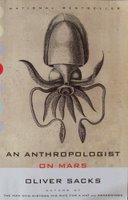The neurologist Oliver Sacks writes in depth about 7 different, strange cases. He writes much more in depth here than in The Man who Mistook his Wife for a Hat, going into greater detail, referencing other research and ideas that relate more generally to the specific case, using these strange conditions to increase and expand our understanding of what it means to be human. In this book, Sacks works to keep an awareness of the individuality and personhood of his patients, and he does that partly through narrative-- by sharing their stories. The book is fascinating and well-written. This is my second reading of this book (the first was several years ago), and I noticed how well-read Sacks is, and not just in the scientific literature of his field. He is familiar with a wide range of literary texts and authors, and he connects them clearly with the scientific cases he discusses.
Each of the seven chapters focuses on a specific case.
The Case of the Colorblind Painter. An adult man develops "achromatopsia" (complete inability to see color) and because he is a painter, he is able to communicate clearly what his colorless world is like. Sacks uses this case to explore theories of color and finds insight into how the brain generates color, which provides us visual stability in a world of shifting wavelengths.
The Last Hippie. A rebellious young man lived as a hippie and then joined a religious cult, where a tumor causing blindness and personality changes went undiagnosed because his demeanor seemed "spiritual." This man's condition is similar to that of lobotomized patients, and Sacks uses this story to go into the history of the lobotomy procedure.
A Surgeon's Life. Sacks spends some time with a surgeon who has Tourettes-- the disease of nervous tics, sudden movements and repeated tic-like words or phrases-- and sees that when he operates on a patient, his Tourettes goes away for the duration of the surgery. Sacks writes about the uninhibited movements of Tourettic people, which gives them incredibly faster reaction times than that of a "healthy" person.
To See and Not See. A man who lost his sight as a child has surgery to remove his cataracts, and must struggle to learn how to process the world by sight instead of touch. [This story was the basis for the movie "At First Sight."] Virgil's struggle to process visual input, and the contrasting ease with which he can identify objects by touch, provides Sacks the opportunity to explain how much of the brain is devoted to interpreting visual input. Seeing and recognizing things seems so natural and instantaneous to us, but this is because as children, a great deal of time and energy was spent training our brains how to process this information. Virgil's story is a sad one-- he never fully acclimates to vision (his restored eyesight is not very good), and his poor health complicates the problem. Sacks also addresses the problem of blindness as a part of Virgil's identity which was lost when he regained his sight.
The Landscape of His Dreams. An Italian man with photographic memory has a mysterious illness, and suddenly finds himself remembering and even re-experiencing Pontito, the small Italian village he grew up in (even in three dimensions, as if he had a model in his head)-- and he discovers he has the artistic skill to paint it with extraordinary accuracy, from any angle. The tradeoff with this extraordinary memory is that Franco is like a man possessed, he lives almost entirely in his past and in his imagined, remembered Pontito.
Prodigies. Sacks talks about savants and prodigies generally, and then gives more detail on a young autistic artist named Stephen who has an extraordinary gift for drawing, particularly architecture. Due to the assistance and kindness of other people, and fame in England due to a documentary, Stephen was able to travel and draw the famous buildings of foreign cities, and his art has been published in several books. Sacks has the opportunity to meet him and travel with him, and struggles to guess what is going on inside his head, and whether he feels any emotion or connection to his traveling companion, who has made his life possible.
An Anthropologist on Mars. Sacks spends some time with a "high functioning" autistic woman named Temple who is a very successful engineer, designing humane facilities for the holding and treatment of cattle and other livestock. Temple is a visual thinker, and easily understands cows, but can only infer the emotions and behaviors of other humans logically, without truly understanding it. Clearly a brilliant woman, Temple also lectures and writes about her autism (she was the first autistic person to publish an autobiography), sees it as part of her identity, and recognizes the strengths and abilities it has granted her, in spite of the aspects of human life she knows she is missing.
The title of the book comes from Temple's description of herself-- because humans and their emotions are, at times, so alien to her. But it applies equally well to Sacks, who investigates into these people with strange conditions that not only affect their abilities, but also their identities, and give us surprising insights into the depth and breadth of what it means to be human.
| Title: | An Anthropologist on Mars: Seven Paradoxical Tales |
|---|---|
| Author: | Oliver Sacks |
| Date published: | 1995 |
| Genre: | Nonfiction |
| Number of pages: | 316 |
| Notes: | Second reading. |



0 comments:
Post a Comment